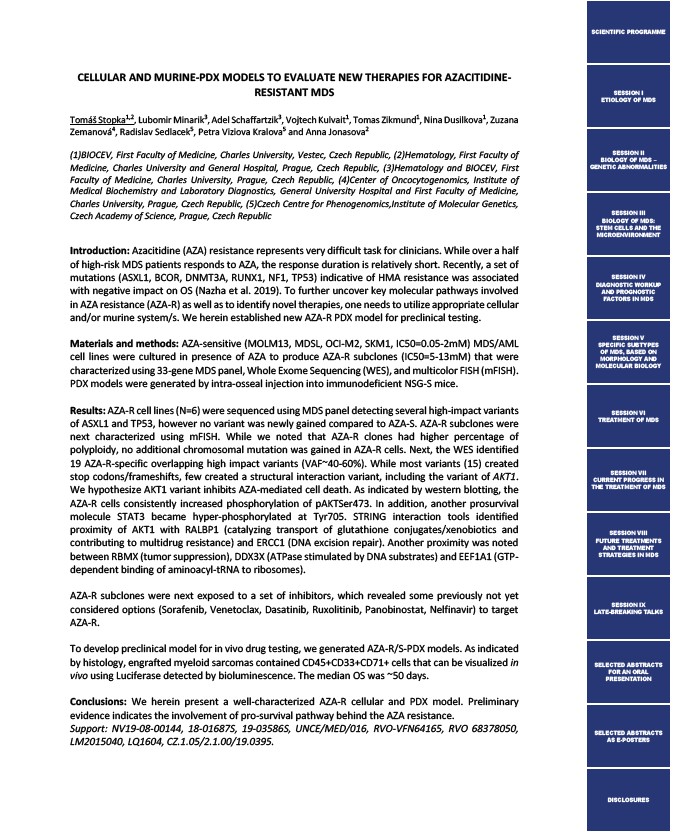
CELLULAR AND MURINE-PDX MODELS TO EVALUATE NEW THERAPIES FOR AZACITIDINE-RESISTANT
MDS
Tomáš Stopka1,2, Lubomir Minarik3, Adel Schaffartzik3, Vojtech Kulvait1, Tomas Zikmund1, Nina Dusilkova1, Zuzana
Zemanová4, Radislav Sedlacek5, Petra Viziova Kralova5 and Anna Jonasova2
(1)BIOCEV, First Faculty of Medicine, Charles University, Vestec, Czech Republic, (2)Hematology, First Faculty of
Medicine, Charles University and General Hospital, Prague, Czech Republic, (3)Hematology and BIOCEV, First
Faculty of Medicine, Charles University, Prague, Czech Republic, (4)Center of Oncocytogenomics, Institute of
Medical Biochemistry and Laboratory Diagnostics, General University Hospital and First Faculty of Medicine,
Charles University, Prague, Czech Republic, (5)Czech Centre for Phenogenomics,Institute of Molecular Genetics,
Czech Academy of Science, Prague, Czech Republic
Introduction: Azacitidine (AZA) resistance represents very difficult task for clinicians. While over a half
of high-risk MDS patients responds to AZA, the response duration is relatively short. Recently, a set of
mutations (ASXL1, BCOR, DNMT3A, RUNX1, NF1, TP53) indicative of HMA resistance was associated
with negative impact on OS (Nazha et al. 2019). To further uncover key molecular pathways involved
in AZA resistance (AZA-R) as well as to identify novel therapies, one needs to utilize appropriate cellular
and/or murine system/s. We herein established new AZA-R PDX model for preclinical testing.
Materials and methods: AZA-sensitive (MOLM13, MDSL, OCI-M2, SKM1, IC50=0.05-2mM) MDS/AML
cell lines were cultured in presence of AZA to produce AZA-R subclones (IC50=5-13mM) that were
characterized using 33-gene MDS panel, Whole Exome Sequencing (WES), and multicolor FISH (mFISH).
PDX models were generated by intra-osseal injection into immunodeficient NSG-S mice.
Results: AZA-R cell lines (N=6) were sequenced using MDS panel detecting several high-impact variants
of ASXL1 and TP53, however no variant was newly gained compared to AZA-S. AZA-R subclones were
next characterized using mFISH. While we noted that AZA-R clones had higher percentage of
polyploidy, no additional chromosomal mutation was gained in AZA-R cells. Next, the WES identified
19 AZA-R-specific overlapping high impact variants (VAF~40-60%). While most variants (15) created
stop codons/frameshifts, few created a structural interaction variant, including the variant of AKT1.
We hypothesize AKT1 variant inhibits AZA-mediated cell death. As indicated by western blotting, the
AZA-R cells consistently increased phosphorylation of pAKTSer473. In addition, another prosurvival
molecule STAT3 became hyper-phosphorylated at Tyr705. STRING interaction tools identified
proximity of AKT1 with RALBP1 (catalyzing transport of glutathione conjugates/xenobiotics and
contributing to multidrug resistance) and ERCC1 (DNA excision repair). Another proximity was noted
between RBMX (tumor suppression), DDX3X (ATPase stimulated by DNA substrates) and EEF1A1 (GTP-dependent
binding of aminoacyl-tRNA to ribosomes).
AZA-R subclones were next exposed to a set of inhibitors, which revealed some previously not yet
considered options (Sorafenib, Venetoclax, Dasatinib, Ruxolitinib, Panobinostat, Nelfinavir) to target
AZA-R.
To develop preclinical model for in vivo drug testing, we generated AZA-R/S-PDX models. As indicated
by histology, engrafted myeloid sarcomas contained CD45+CD33+CD71+ cells that can be visualized in
vivo using Luciferase detected by bioluminescence. The median OS was ~50 days.
Conclusions: We herein present a well-characterized AZA-R cellular and PDX model. Preliminary
evidence indicates the involvement of pro-survival pathway behind the AZA resistance.
Support: NV19-08-00144, 18-01687S, 19-03586S, UNCE/MED/016, RVO-VFN64165, RVO 68378050,
LM2015040, LQ1604, CZ.1.05/2.1.00/19.0395.
SCIENTIFIC PROGRAMME
SESSION I
ETIOLOGY OF MDS
SESSION II
BIOLOGY OF MDS –
GENETIC ABNORMALITIES
SESSION III
BIOLOGY OF MDS:
STEM CELLS AND THE
MICROENVIRONMENT
SESSION IV
DIAGNOSTIC WORKUP
AND PROGNOSTIC
FACTORS IN MDS
SESSION V
SPECIFIC SUBTYPES
OF MDS, BASED ON
MORPHOLOGY AND
MOLECULAR BIOLOGY
SESSION VI
TREATMENT OF MDS
SESSION VII
CURRENT PROGRESS IN
THE TREATMENT OF MDS
SESSION VIII
FUTURE TREATMENTS
AND TREATMENT
STRATEGIES IN MDS
SESSION IX
LATE-BREAKING TALKS
SELECTED ABSTRACTS
FOR AN ORAL
PRESENTATION
SELECTED ABSTRACTS
AS E-POSTERS
DISCLOSURES